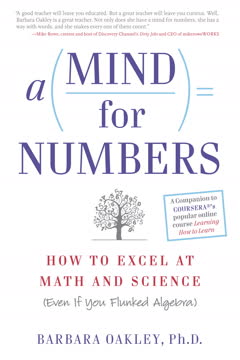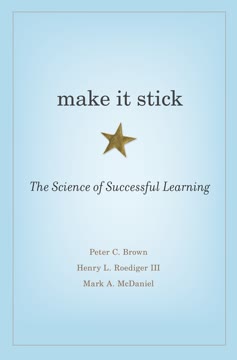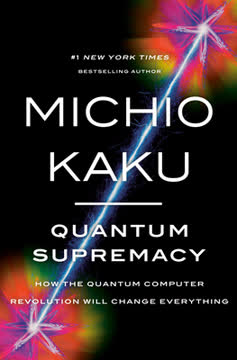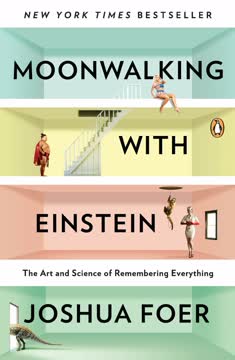Key Takeaways
1. Unlock Your Memory Potential with Association, Location, and Imagination
The three keys to developing a highly efficient memory are Association, Location and Imagination (think of Mohammad ALI to help you remember them).
Association is key. The human brain excels at making connections between seemingly unrelated items. By deliberately creating vivid, often bizarre associations, you can transform abstract information into memorable images. For example, to remember the name "Rupert Watts," you might picture Rupert Bear changing a light bulb in a dentist's office.
Location anchors memories. Our brains naturally organize memories spatially. The Journey Method capitalizes on this by placing mental images along a familiar route, such as your home or a favorite walk. This provides a structured framework for recalling information in sequence.
Imagination amplifies recall. The more creative and emotionally engaging your mental images, the more likely you are to remember them. Engage all your senses and inject humor or absurdity into your visualizations to make them stand out. For instance, imagining a giant snowball rolling through your living room is more memorable than simply thinking of the word "snowball."
2. Master the Journey Method for Memorizing Sequences
The journey preserves the order of the rows, while each story I create preserves the order of the images within each row.
Create mental journeys. Develop a set of familiar routes with distinct, memorable locations. These can be based on your home, workplace, or favorite walking paths. The key is to have a clear sequence of stages that you can mentally navigate with ease.
Place information along the route. As you encounter items you need to memorize, transform them into vivid mental images and place them at specific points along your journey. For example, to remember a shopping list, you might imagine a giant tomato blocking your path at the first stop, then crossing a bridge covered in slippery avocado at the second.
Review and recall. To solidify the memories, mentally walk through your journey, visualizing each item in its place. With practice, you'll be able to recall long lists of information simply by retracing your mental steps. This method is particularly effective for memorizing speeches, shopping lists, and other sequential information.
3. Harness the Power of the Dominic System for Numbers and Cards
Groups of five numbers were too complicated – instead, I should be grouping the numbers into only pairs.
Convert numbers to letters. The Dominic System assigns specific letters to each digit from 0 to 9. For example, 1=A, 2=B, 3=C, and so on. This forms the foundation for creating memorable images from numbers.
Create character codes. Group numbers into pairs and convert them into initials. These initials then become the basis for assigning characters. For instance, 14 might become AD, which could represent Addie, a friend from your golf club.
Develop complex images. Combine characters with actions or props to create more elaborate mental images. This allows you to memorize four digits at once. For example, 1423 could become Albert Einstein (14) playing tennis (23).
- Number-to-letter conversion: 1=A, 2=B, 3=C, 4=D, 5=E, 6=S, 7=G, 8=H, 9=N, 0=O
- Character examples: 14=AD=Addie, 23=BC=Bill Clinton
- Complex image example: 1423 = Albert Einstein (14) playing tennis (23)
4. Boost Your Brain's Performance Through Lifestyle Choices
Physical exercise, good nutrition, intellectual stimulation, and making time for relaxation, all play their part in ensuring that you stay mentally pin-sharp.
Exercise for brain health. Regular physical activity, particularly aerobic exercise, improves blood flow to the brain and stimulates the growth of new brain cells. Aim for at least 20-30 minutes of exercise that leaves you slightly breathless, 2-3 times a week.
Nourish your neurons. A diet rich in omega-3 and omega-6 fatty acids, B-vitamins, choline, and antioxidants supports optimal brain function. Key foods include:
- Oily fish (salmon, tuna, mackerel)
- Nuts and seeds
- Eggs
- Colorful fruits and vegetables (berries, spinach, broccoli)
Manage stress and stimulate your mind. Chronic stress can inhibit the growth of new brain cells, particularly in memory-related areas. Combat this through relaxation techniques, engaging hobbies, and continuous learning. Regularly challenging your brain with memory exercises, puzzles, and new skills helps maintain cognitive function as you age.
5. Apply Memory Techniques to Everyday Life and Professional Success
Keeping track of a conversation is a wonderful skill to have, no matter what you do.
Enhance social interactions. Use memory techniques to remember names and details about people you meet. This can significantly improve your personal and professional relationships. For example, when introduced to someone named "Tina Bellingham," you might imagine a tiny person ringing a bell coated with ham.
Boost workplace productivity. Apply memory methods to retain important information from meetings, presentations, and training sessions. This can reduce reliance on written notes and improve your ability to recall key details on demand.
Master public speaking. Use the Journey Method to memorize speeches and presentations without relying on notes. This allows for more natural and engaging delivery, as you can maintain eye contact and respond flexibly to your audience.
- Remembering names: Create vivid associations with physical features or name meanings
- Meeting recall: Use number-shape systems to anchor key points in order
- Speech memorization: Place main points of your talk along a familiar mental journey
6. Overcome Age-Related Memory Decline Through Constant Mental Exercise
I believe that my constant work with memory techniques – whether I'm teaching, coaching, performing or competing – has kept my powers of recall and concentration in fantastic shape.
Challenge the notion of inevitable decline. Research suggests that cognitive decline is not an unavoidable consequence of aging. Instead, it's often related to lack of mental stimulation, poor health habits, and reduced social engagement.
Engage in regular mental workouts. Treat your brain like a muscle that needs consistent exercise to stay strong. Memory techniques provide an excellent form of mental training:
- Practice memorizing decks of cards
- Learn and recall long number sequences
- Memorize poems or speeches
- Apply techniques to learn new languages or skills
Combine mental and physical exercise. Integrate memory training with physical activity for optimal brain health. For example, memorize information while walking or practice recall during workout breaks. This multi-faceted approach helps maintain cognitive function and may even improve it as you age.
7. Transform Public Speaking and Learning with Advanced Memory Strategies
Mind Maps provide a visual means by which to organize information around a central topic.
Revolutionize speech preparation. Use Mind Maps to brainstorm and organize your thoughts visually. Place your main topic in the center and branch out with related ideas, using colors and images to enhance recall. This approach allows for more creative and comprehensive speech planning.
Enhance learning efficiency. Apply the Rule of Five for effective review:
- Review immediately after learning
- Review again after one day
- Review after one week
- Review after one month
- Final review after 3-6 months
Master complex information. Combine multiple memory techniques for tackling challenging subjects:
- Use the Journey Method to memorize the overall structure of a topic
- Apply the Dominic System for remembering specific facts and figures
- Create Mind Maps for visual organization and connection of ideas
- Implement spaced repetition (Rule of Five) to solidify long-term recall
By integrating these advanced strategies, you can dramatically improve your ability to learn, retain, and present complex information in both academic and professional settings.
Last updated:
FAQ
What's "You Can Have an Amazing Memory" about?
- Author's Background: The book is written by Dominic O'Brien, an eight-time World Memory Champion known for his extraordinary memory feats.
- Memory Techniques: It provides life-changing techniques and tips to improve memory, drawing from O'Brien's personal experiences and methods.
- Journey Method: A significant focus is on the Journey Method, a technique that uses familiar routes to memorize information.
- Practical Applications: The book covers practical applications of memory techniques in everyday life, such as memorizing names, numbers, and speeches.
Why should I read "You Can Have an Amazing Memory"?
- Improve Memory Skills: The book offers proven techniques to enhance memory, which can be beneficial in both personal and professional settings.
- Boost Confidence: By improving memory, readers can gain self-confidence and self-belief, as demonstrated by O'Brien's own journey.
- Comprehensive Guide: It provides a step-by-step guide to various memory techniques, making it accessible for beginners and advanced learners alike.
- Real-Life Examples: O'Brien shares personal anecdotes and examples, making the techniques relatable and easier to understand.
What are the key takeaways of "You Can Have an Amazing Memory"?
- Journey Method: This method involves using familiar routes to memorize information, making it easier to recall.
- Association and Imagination: The book emphasizes the power of association and imagination in creating memorable links between information.
- Review Strategies: O'Brien introduces the Rule of Five, a strategy for reviewing information to ensure it sticks in long-term memory.
- Everyday Applications: The techniques can be applied to everyday tasks, such as memorizing shopping lists, appointments, and speeches.
How does the Journey Method work in "You Can Have an Amazing Memory"?
- Familiar Routes: The Journey Method uses familiar routes, such as a walk through a neighborhood, to create a mental map for memorization.
- Stages and Stops: Each stop along the journey represents a piece of information, making it easier to recall in sequence.
- Visual and Emotional Cues: By associating vivid images and emotions with each stop, the information becomes more memorable.
- Practical Examples: O'Brien provides examples of how he uses this method to memorize decks of cards and long sequences of numbers.
What is the Rule of Five in "You Can Have an Amazing Memory"?
- Review Strategy: The Rule of Five is a strategy for reviewing information five times to ensure it is retained in long-term memory.
- Immediate Review: After memorizing information, an immediate review helps reinforce the memory.
- Subsequent Reviews: Additional reviews are spaced out over time to strengthen recall and prevent forgetting.
- Application: This method is particularly useful for memorizing large amounts of data, such as numbers or cards.
How does Dominic O'Brien suggest using imagination in memory techniques?
- Creative Visualization: Imagination is used to create vivid, memorable images that link pieces of information together.
- Engaging Senses: By engaging all senses—sight, sound, taste, touch, and smell—memories become more vivid and easier to recall.
- Emotional Connections: Associating emotions with images helps to reinforce the memory, making it more likely to stick.
- Practical Exercises: The book includes exercises to practice using imagination, such as visualizing scenarios with unusual sensory combinations.
What are some practical applications of memory techniques in "You Can Have an Amazing Memory"?
- Memorizing Names: Techniques for associating names with faces, using visual and auditory cues, are provided.
- Remembering Numbers: The Dominic System is introduced for converting numbers into memorable images.
- Speech Preparation: The Journey Method can be used to memorize speeches, ensuring smooth delivery without notes.
- Daily Tasks: Techniques can be applied to everyday tasks like shopping lists and appointments, improving efficiency and organization.
What is the Dominic System in "You Can Have an Amazing Memory"?
- Number Conversion: The Dominic System converts numbers into letters, which are then associated with people or objects.
- Character Assignments: Each number pair is assigned a character, making it easier to create memorable associations.
- Complex Images: By combining characters with actions or props, complex images are formed to memorize longer sequences.
- Practical Use: This system is particularly effective for memorizing long sequences of numbers, such as phone numbers or historical dates.
How does "You Can Have an Amazing Memory" address age-related memory decline?
- Challenging Myths: O'Brien challenges the notion that memory declines with age, emphasizing that memory can improve with training.
- Healthy Lifestyle: The book highlights the importance of a healthy lifestyle, including diet and exercise, for maintaining memory.
- Mental Stimulation: Regular mental exercises, such as memory training, can keep the brain sharp and improve cognitive function.
- Positive Attitude: A positive attitude and motivation are crucial for maintaining and improving memory at any age.
What are the best quotes from "You Can Have an Amazing Memory" and what do they mean?
- "The mind is like a trunk: if well-packed, it holds almost everything; if ill-packed, next to nothing." This quote emphasizes the importance of organizing information effectively for better memory retention.
- "Succeeding starts with believing." O'Brien highlights the role of self-belief and confidence in achieving memory improvement.
- "Your memory will start to feel like it’s getting bigger, better and stronger every day." This quote reflects the transformative power of memory training on cognitive abilities.
- "When you begin to push the boundaries of what you thought was possible, you experience a surge in self-confidence." O'Brien underscores the broader benefits of memory training beyond just recall.
How can "You Can Have an Amazing Memory" help with studying and learning?
- Efficient Reading: The book suggests using a pointer to increase reading speed and concentration, improving information retention.
- Note-Taking: Mind Maps® are recommended for organizing information visually, aiding in understanding and recall.
- Memorizing Dates: Techniques like the Dominic System help in memorizing important dates and events for exams or presentations.
- Review Techniques: The Rule of Five and other review strategies ensure that learned information is retained long-term.
What exercises does "You Can Have an Amazing Memory" include for memory improvement?
- Baseline Tests: The book includes initial tests to measure memory capacity before applying techniques.
- Memory Storytelling: Exercises involve creating stories to link words or numbers, enhancing recall.
- Binary Digits Practice: Memorizing binary sequences is used as a challenging exercise to improve memory agility.
- Names and Faces: Exercises for associating names with faces help improve social memory skills.
Review Summary
You Can Have an Amazing Memory receives mostly positive reviews, with readers praising its practical techniques and exercises for improving memory. Many find the author's personal experiences and explanations of brain function engaging. The book covers various methods like the journey system, association, and visualization. Some criticize its focus on memorizing cards and numbers, wanting more real-world applications. Overall, readers report noticeable improvements in their memory skills after applying the techniques, though consistent practice is necessary for best results.
Similar Books










Download PDF
Download EPUB
.epub digital book format is ideal for reading ebooks on phones, tablets, and e-readers.







